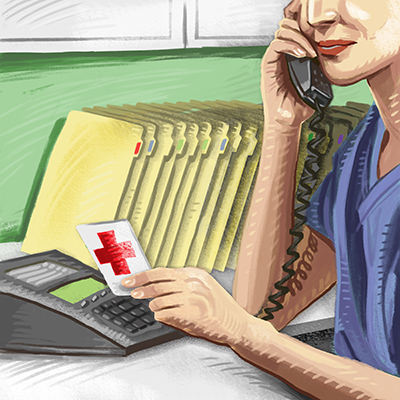Medical Emergencies: Are You Really Prepared?
By Ben Quenzer, M.D.
 Over the last five years, I've enjoyed teaching seminars and classes on medical emergencies and resuscitation. One thing that surprised (and terrified) me was the inevitable "crash and burn" that would happen as participants attempted to take care of a mock emergency. Time and time again,
Over the last five years, I've enjoyed teaching seminars and classes on medical emergencies and resuscitation. One thing that surprised (and terrified) me was the inevitable "crash and burn" that would happen as participants attempted to take care of a mock emergency. Time and time again,
providers would forget CPR, AED usage, or basic emergency treatment. Obviously,
emergencies are rare and because they are rare, we tend to get rusty. It makes sense, of course, because most providers only see a few true emergencies in their career. Therein lies the problem: how can a provider be prepared for something they might see once or twice in a decade?
The answer is, practice. With any dental technique, you get better with practice! The same is true of resuscitation. As we spend the day training with mannequins,
the participants in my courses find that the knot in their stomach gets smaller and smaller. Doctors routinely come up at the end of seminars and say things like, "I feel so much more confident if something were to happen." Indeed, this is the goal; to become confident during emergencies through preparation and practice. With this goal in mind, let me share a few ideas.
Real-time Practice
There is no substitute for running through an emergency as if it was actually happening! Instead of saying, "I would give oxygen." the providers need to go get the emergency oxygen, turn it on, and actually administer the oxygen to either a mannequin or a fellow staff member. Create muscle memory for the actual steps that are taken in an emergency. Open the medical kit, remove the medicines, and practice saying the doses. Count out loud the cadence for chest compressions and locate the landmarks. Be sure to include real-time dialogue that ends in action. Don't simply practice saying, "I would do this." but actually do it! My best advice is to have solid practice time at least twice a year with the entire office. Whether that training takes place in a formal course or simply an extended staff meeting, it needs to be often.
Focus on Common Emergencies and the Treatment
Common things are common and hence, those are the emergencies you are most likely to see. Review with the office staff emergencies such as syncope, heart attack, seizure, anaphylaxis, overdose, and others. In a simple lunch hour staff meeting, the staff can review these concepts and be prepared to identify and treat them. Want to take it a step further? Have the emergency medical kit out on the table during the discussion and review the drugs that would be useful.
Know Your Basic Life Support
Most offices have a fireman or other individual come in every few years for 30-45 minutes, review BLS, help folks through the test, and give everyone a new CPR card. While I understand this is a reality, it is most unfortunate. The vast majority of dentists and their staff cannot reliably remember basic CPR when called upon to actually push on the chest. This has been the case for as long as I have been training. I have noticed something very important as I have participated in hundreds of medical emergencies. BLS SAVES LIVES! Practitioners need quality time on the mannequins to establish good muscle memory for breathing, compression, and finding landmarks. Quality time includes each team member performing CPR correctly and for several minutes. Each office needs to set aside time to train every six months on BLS.
Knowing the basic steps and flow of CPR is paramount and can keep patients alive whether we can diagnose the problem or not. Check for breathing. Check for a pulse. These two steps alone are SO important. If they aren't breathing, they need breaths. If they don't have a pulse, they need chest compressions. Obviously, there are more steps to BLS, but I am amazed at how often these two things are overlooked as the patient deteriorates. I often get my students to repeat with me the mantra: Check for breathing. Check for pulse!
Certainly, we all hope that a medical emergency never comes our way. However, the odds are that each of us will probably see at least one or two. A few simple practice sessions can go a long way towards mitigating the paralyzing fear that grips us as we realize that a patient is dying. I truly believe that lives can be saved by taking the time to cement in our minds the steps of BLS, and practicing them on a routine basis.
Dr. Ben Quenzer is a Board-certified anesthesiologist and president of North Dallas Anesthesia. He performs IV sedation for oral surgery and dental procedures. He teaches seminars on managing medical emergencies and trains dental offices on how to prepare for emergencies. Dr. Quenzer earned his undergraduate degree at Brigham Young University. He attended Baylor College of Medicine for medical school and completed a four-year anesthesia residency at Wake Forest University.
He can be reached atndasedation@yahoo.com.




